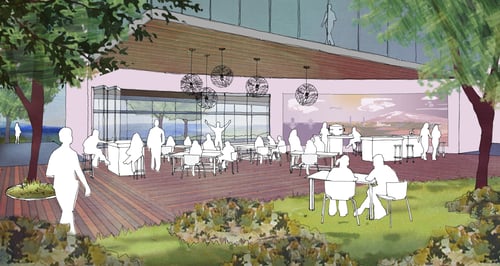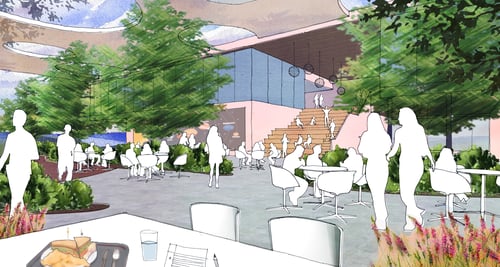Creating Better Outdoor Learning Spaces
Researchers agree that outdoor education improves students’ physical and emotional health and teaches them valuable social skills, in addition to providing hands-on learning opportunities.
But not all school outdoor spaces are equal. Creating effective outdoor learning environments requires specific design strategies and a willingness of educators to embrace different teaching methods.
In a roundtable discussion, three LPA education design specialists explore the nuances and challenges of developing engaging outdoor spaces for K-12 campuses that provide better results for educators.
Each brings a unique specialty to the table—Dr. Julie Zoellin Cramer is a widely-respected education research consultant; Kate Mraw is a leader in research-based interior designs; and Kari Kikuta is the Director of Landscape Architecture at LPA.
As the talk flowed, each expressed strong ideas on the best way to develop and program efficient outdoor spaces.
What’s the first step in designing better outdoor learning spaces?
 Dr. Julie Zoellin Cramer: We start the conversation by asking educators about their most memorable learning experience. Nine times out of 10, their response is something outdoors—it’s the playground, a special field trip or an outdoor activity. They remember the environments where they had the ability to have unfocused attention—when students are free to experience Eureka moments.
Dr. Julie Zoellin Cramer: We start the conversation by asking educators about their most memorable learning experience. Nine times out of 10, their response is something outdoors—it’s the playground, a special field trip or an outdoor activity. They remember the environments where they had the ability to have unfocused attention—when students are free to experience Eureka moments.
Kate Mraw: We also ask the client deeper questions, not just about what features they want, but defining the activities that will happen in those spaces. We try to visualize and plan for how the space will be used. Even in outdoor learning environments, the “why” comes from understanding who is using the space and the student’s needs.
How do you overcome resistance?
JZC: We have a conversation about the different types of learning and the value of each of them. The types of spaces that meet human needs support cognitive, social, creative, restorative and gathering activities. The ultimate, effective outdoor space not only considers what you can learn cognitively from being outdoors but includes other learning aspects.
What do traditional outdoor spaces get wrong?
Kari Kikuta: Too many schools don’t take the opportunity to use spaces for dual purposes. What is commonly seen is a playground placed in the back of the school, and no one is using the space when it’s not recess. When we think about square footage and the footprint of a school, it’s important to infuse play and learning spaces to essentially expand the footprint of that campus.
KM: Strategic programming requires that a space isn’t over- or under-designed. When it’s too flexible, for instance, there’s no intuition of how to use the space, so it becomes underutilized. On the other hand, if it’s programmed too specifically, it loses the adaptability to use the environment in different ways. We try to find the balance. The design should cue behavior—guiding users on how to use the space—while remaining flexible enough for anyone to personalize the use.
How do you get educators involved?
 KK: Teachers are more willing to participate in outdoor learning when they can see what’s happening outdoors. Many schools use a pinwheel layout to their campus, where outdoor spaces are hidden between buildings, which makes it difficult to see what the kids are doing. There’s no connection to the classroom buildings. On one project, we designed the site plan so the teachers could oversee the outdoor spaces from both sides, making them feel more comfortable with safety and security. With glazing all along the classroom side, they could send kids outside and remain connected.
KK: Teachers are more willing to participate in outdoor learning when they can see what’s happening outdoors. Many schools use a pinwheel layout to their campus, where outdoor spaces are hidden between buildings, which makes it difficult to see what the kids are doing. There’s no connection to the classroom buildings. On one project, we designed the site plan so the teachers could oversee the outdoor spaces from both sides, making them feel more comfortable with safety and security. With glazing all along the classroom side, they could send kids outside and remain connected.
KM: We also consider how to create similarities between the indoors and out, where this line blurs or, ideally, disappears. In order for this to occur, there has to be relatable programming on either side of the doors. Roll-up and sliding doors are important elements in blurring that line, making it easy to move furniture, materials and students outside.
But isn’t that direct connection also a distraction?
JZC: Distractions are part of the learning process. Students need to learn how to refocus and redirect their attention or engage in that distraction. Research shows that when you have views to the outdoors, whether others are using the space or not, it allows students to take a mental break. It can reenergize them, then refocus them in a better, stronger, more dedicated way.
KM: Plus, you can learn from play. At Menchaca Elementary School in Austin, Texas, the play space is inside the quad. We discussed advantages with the client, including gross motor skills, social interactions and other learning aspects often forgotten. If you’re doing it right, other teachers will learn from what they’re seeing outside their classroom and how they can use that space.
Is there a difference between learning and play space?
KK: Tarbut V’Torah [a K-12 school in Orange County] is a great example of having a limited site, so we had to combine play and learning spaces. Students go outside for various lessons. They play, they find their inner artist, they create skits and use their imagination in the outdoor amphitheater. The space was originally designed for the elementary school students, and over time the middle schoolers began to play on the outdoor equipment. The design of the play area was eventually expanded because it was so popular.
KM: If we had only programmed a play space, the typical response would be play structures and common elements found at a park or traditional elementary school. However, because we were challenged to combine a play space with a learning space, we found a natural overlap to achieving the goals of both learning and exploration.
Is there a conflict between connecting the indoor and outdoor spaces and energy efficiency?
 KM: Just like any project, planning for the connections between indoors and out is part of problem solving and coordination with the mechanical strategy. It’s the awareness of how we plan to design the space. If a space is going to be a hybrid between an interior enclosed and the outdoors with rollups, knowing that ahead of time is going to play into how you condition it. In California, we may also consider that perhaps the space isn’t conditioned because it may be open all the time. And that passive transition zone between the outdoors and indoors can be a real connector on campus.
KM: Just like any project, planning for the connections between indoors and out is part of problem solving and coordination with the mechanical strategy. It’s the awareness of how we plan to design the space. If a space is going to be a hybrid between an interior enclosed and the outdoors with rollups, knowing that ahead of time is going to play into how you condition it. In California, we may also consider that perhaps the space isn’t conditioned because it may be open all the time. And that passive transition zone between the outdoors and indoors can be a real connector on campus.
How do you design an outdoor space that engages on social, creative or restorative levels?
JZC: Often when we think about outdoor learning, we think of loud, large motor activities, so we plan for this level of interactivity. But we know from attention restoration theory, there’s also a restorative function to being in nature. By interacting with your environment, your senses are engaged. You can touch, feel, smell and move.
We want students to be able to go outside and take part in the activities that relax their mind, open it up to other possibilities and learn from what emerges from their unconscious. This requires an environment that’s not completely directed and can be used in a more intuitive way.
KK: These spaces allow for students to direct their own activities and are designed with a balance of structure and flexibility. By not enclosing or limiting too much of the design features, we’re allowing for creativity and freedom because they’re being more imaginative versus being guided.
This story originally appeared in the latest edition of Catalyst, a quarterly publication that takes a deep dive into the new ideas, industry leaders and cutting-edge initiatives changing lives by design.
